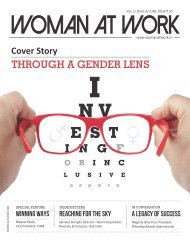February 2016 Woman At Work Digital
You also want an ePaper? Increase the reach of your titles
YUMPU automatically turns print PDFs into web optimized ePapers that Google loves.
to an article or intended to be applied<br />
by industrial process or means. To<br />
understand this, let’s take an example<br />
of a tissue paper holder. A new design<br />
can imply new appearance, shape or<br />
configuration.<br />
The scope of protection of<br />
Industrial designs varies from<br />
packaging, handicrafts, furnishing,<br />
textiles, jewelry, utility products,<br />
appliances, Graphic symbols and<br />
logos, surface patterns, ornamentation<br />
to furniture. As per the IPO (Indian<br />
Patent Office) the registration of a<br />
design confers upon the registered<br />
proprietor ‘Copyright’ in the design<br />
for the period of registration. Here<br />
‘Copyright’ means the exclusive right<br />
to apply a design to the article<br />
belonging to the class in which it is<br />
registered. A proprietor of an ID<br />
(Industrial Design) can apply for the<br />
registration of that design. The rights<br />
offered by an industrial design can<br />
protect shape, configuration, and<br />
pattern of lines etc. that is applied to<br />
an article. In general, the ID protects<br />
the aesthetics that is visible to the eye<br />
of a viewer. The ID may not be able<br />
to protect an invention or technical<br />
solution or functionality or inventive<br />
concept of a product or technical<br />
features present inside the product.<br />
It is worthwhile to note that the<br />
protection conferred by ID is limited<br />
to the applications of the design.<br />
There are generally 32 classes in<br />
which one can protect an industrial<br />
design. This classification (popularly<br />
referred as Locarno Classification) is<br />
an alphabetical list of goods which<br />
constitute industrial designs, with an<br />
indication of the classes and<br />
subclasses into which they fall.<br />
Generally the proprietor or the lawyer<br />
of the proprietor selects one or more<br />
classes depending upon the nature of<br />
use and application of the design.<br />
For example, suppose a designer<br />
designs a set of gloves with integrated<br />
scrubber (Gloves-Scrubber) for<br />
washing utensils in the gloves. After<br />
registration, the right will be limited<br />
to the shape and configuration of<br />
the product. Another designer may<br />
create a set of ‘Scrubber Gloves’<br />
with a completely different shape<br />
and configuration. Here, one should<br />
note that the owner of the registered<br />
design can only protect the shape<br />
and configuration developed by her.<br />
However, such design neither<br />
provides protection to the<br />
technology of making the glove or<br />
method of fusing scrubber with<br />
gloves. Further, the registered<br />
design may not be able to protect<br />
the technical or functional features<br />
of the product. The owner may<br />
consider patent registration in<br />
addition to design registration to<br />
seek protection for technology<br />
involved with regard to such<br />
product. In this case it is<br />
recommended to protect the design<br />
of the Gloves-Scrubber in the<br />
classes of gloves as well as<br />
scrubbers. The proprietor will have<br />
the protection in the two classes.<br />
The owner of a registered<br />
design has the right to prevent third<br />
parties from making, selling or<br />
importing articles bearing or<br />
embodying a design which is a copy<br />
of the protected design, when such<br />
acts are undertaken for commercial<br />
purposes.<br />
Although the rights conferred by<br />
the patent and design registration<br />
are similar but nature of protection<br />
is different. Let’s understand in<br />
details on the meaning of violation<br />
of rights of a registered design or<br />
piracy of designs. If a registered<br />
design or its imitation is applied to<br />
any article in the same class of<br />
article of registered design without<br />
the written consent of the registered<br />
proprietor for the purpose of selling<br />
or importing that article then such<br />
acts amounts to piracy of the<br />
registered design.<br />
It is to be noted that any artistic<br />
work protectable under copyrights<br />
will not get protection that a<br />
registered design receives. For<br />
example, a painting, a sculpture, a<br />
drawing, a photograph should be<br />
protected by Copyrights and not by<br />
the provisions of ID. So any new<br />
design that is appealing to the eye<br />
and that is new, can be protected<br />
under the provisions of Industrial<br />
Design in India and if required the<br />
protection may be extended beyond<br />
national boundaries in the countries<br />
of interest. We should recommend<br />
creative artists or product designers<br />
around us so as to protect their<br />
creative designs before disclosing<br />
them to public. The owner of the<br />
design may enjoy the exclusivity for<br />
a term of 10 years from the date of<br />
filing which is further extendable by<br />
another five years. And then the<br />
protected designs would be<br />
commercialized by licensing the<br />
rights to use the registered design.<br />
Design registration confers<br />
non-exclusive rights to the owner of<br />
the design. The design registration<br />
should not be confused with the<br />
patent registration.<br />
anand@krishnaandsaurastri.com<br />
42<br />
| <strong>February</strong> <strong>2016</strong>














